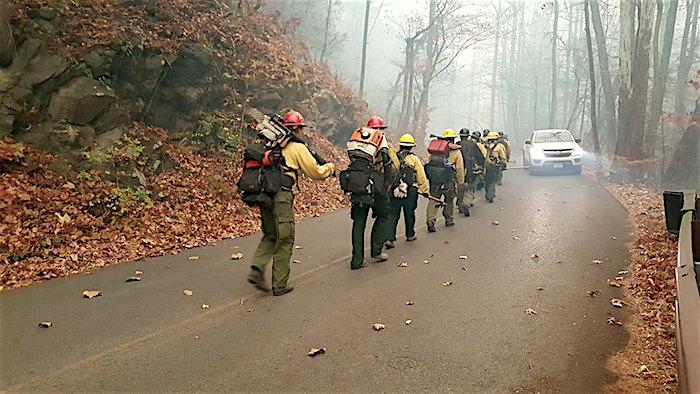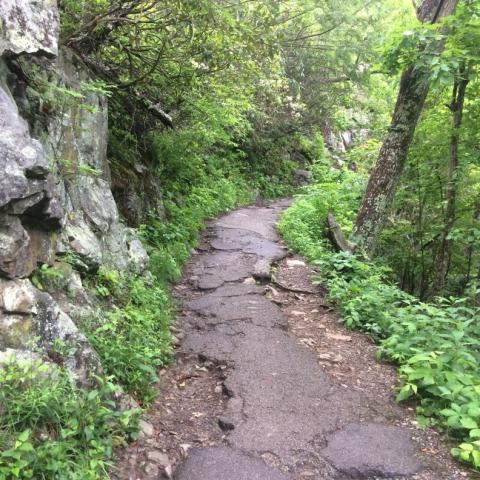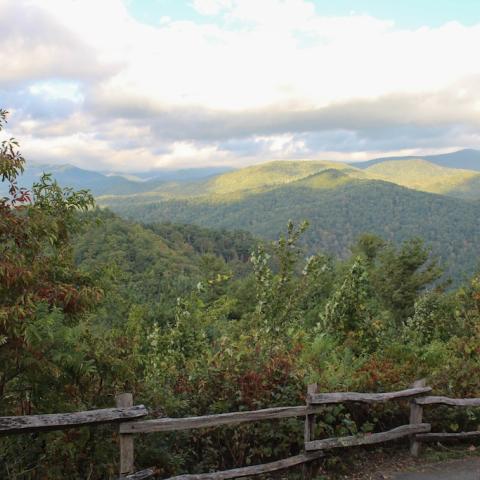
Among the structures claimed by the flames was this one in Wears Valley that borders the park on Cove Mountain/Gary Wilson
Editor's note: This updates with three fatalities reported, acreage burned estimated at more than 15,000 acres, crews still fighting fires and assessing damage in the park.
At least three people were killed by fires that swept more than 15,000 acres in Great Smoky Mountains National Park and neighboring Gatlinburg, Tennessee, where more than 100 buildings, including a 16-story hotel in the colorful resort town, were damaged or destroyed. Crews worked into the night Tuesday to continue to assess damage in the park, though the historic LeConte Lodge was said to have survived the conflagration without damage.
There were no immediate details on the fatalities, other than that they occurred at three different locations.
While Gatlinburg remained under a mandatory evacuation order heading into the evening Tuesday, a similar order for Pigeon Forge was lifted, according to the Tennessee Emergency Management Agency.
Crews were continuing late Tuesday to make damage assessments in Gatlinburg, which was overrun by flames from wildfires blown out of the national park by winds gusting above 70 mph, while elsewhere firefighters continued their gritty tasks in and outside of the park.
The weather forecast was concerning: it called for "marginally severe" storms Tuesday night into Wednesday morning that could produce heavy downpours as well as winds gusting to 60 mph.
"Thunderstorms and winds will pick up around midnight tonight with a potential to cause more trees to fall," the park tweeted.
As many as 14,000 people were estimated to have been evacuated from Gatlinburg late Monday into Tuesday as fire rained down on the town. The western entrance to the national park there was closed to all but emergency vehicles, and staff were assessing damage to structures inside the park. The historic LeConte Lodge was spared by the flames, as was the Elkmont Campground and facilities there, although some roof damage was reported at Elkmont due to falling trees, park officials reported.
"If you're a person of prayer, we could use your prayers," Gatlinburg Fire Chief Greg Miller said during a briefing Monday night while fires flickered on the mountainsides that rim the town.
At the Tennessee Emergency Management Agency, officials said hundreds of firefighters were joining the battle against the flames in a region mired in its worst drought in decades. Tennessee Gov. Bill Haslam called out the National Guard to help as well.
"State agencies and local officials evacuated likely thousands residents and visitors from Sevier County last night due to devastating wildfires in-and-around the cities of Gatlinburg and Pigeon Forge. It is very likely 14,000+ residents and visitors evacuated from Gatlinburg alone," the agency reported Tuesday morning. "The Chimney Top Fire, which began in the Great Smoky Mountains, spread very rapidly yesterday evening as high winds pushed flames onto private property.
"Even with the rain that is currently falling there, the fires continue to burn and structures remain engulfed with little hope that the rainfall will bring immediate relief."
At one point nearly 12,000 people in the area were said to be without electricity.

Firefighters, some from as far away as Utah, were called in to help battle forest fires in Great Smoky Mountains National Park/NPS
The conflagration was traced to a small, 1.5-acre fire reported last Wednesday near the summit of the Chimney Tops Trail in the park. While crews attacked the flames, the tinder-dry forests and gusting winds quickly took control of the blaze and blew it up Sunday night to an estimated 500 acres. By Monday another 150-acre fire was reported not far east of Gatlinburg at the Twin Creeks Picnic Pavilion along the Cherokee Orchard Road inside the park. While that led to a voluntary evacuation of the Mynatt Park neighborhood that borders the park, strong winds throughout the day showered the town with fire.
"Wind gusts carried burning embers long distances, causing new spot fires to ignite across the north-central area of the park and into Gatlinburg," Gatlinburg officials said in a release Tuesday morning. "In addition, high winds caused numerous trees to fall throughout the evening on Monday, bringing down power lines across the area that ignited additional new fires that spread rapidly due to sustained winds of over 40 mph.
"Conditions remain extremely dangerous with trees expected to continue to fall. Officials are asking that motorists stay off the roadways throughout the area. Travel in the Gatlinburg area is limited to emergency traffic only. The national park is closed at the Gatlinburg entrance."
Damage also was reported in nearby Pigeon Forge, the Wears Valley, and Jones Cove, though details were sparse.
Inside the park, all facilities were closed due to "extensive fire activity and downed trees." Park headquarters was without electricity and phone service. While Cades Cove remained open, visitors were advised to "come in through Townsend. Still best to visit the North Carolina side of the park." Park staff also were checking on the status of historic buildings. A better assessment of damage was expected late Tuesday afternoon.
Firefighters Monday struggled against winds gusting to nearly 75 mph as they tried to control the Chimney 2 Fire.
"Resources in and around the park are strained to breaking points. Please avoid the Tennessee side of the park and visit the North Carolina side," the park said on Twitter early Tuesday. "More fire crews arriving today. Wildfire broke past park and damaged Gatlinburg and Pigeon Forge."
The cause of the fire was not known, though it was suspected to have been human caused.
Park officials reported additional fire activity in "the park headquarters area and a spot fire between Elkmont and Newfound Gap Road off of the Sugarland Mountain Trail approximately 1 mile south of the Husky Gap Trail intersection. The park has closed the Gatlinburg Bypass and Little River Road from Sugarlands Visitor Center to Metcalf Bottoms Picnic Area due to fire activity and downed trees. The park has evacuated employees from the Elkmont and Park Headquarters housing areas."



 Support Essential Coverage of Essential Places
Support Essential Coverage of Essential Places







Comments
None of which meaured addressed "minority" views, most of which discuss effects of global warming without any evidence of a human cause and some repeat already disproven claims and predictions.
I will ask again, if the science is proven, why has the science been so wrong? ......Crickets.
As to soulectomy - its call "personal responsiblitly". I concept that appears to be beyond your grasp.
Yep, just as I thought. He only repeats the same rhetoric over and over and can never go deep into any response because he's not programmed nor capable of doing it. We are dealing with a mindless bot here.
Because you never answer the question. It not rhetoric, its fact. The predictions based on "settled science" have been horribly wrong. The world hasn't heated as projected. There haven't been more and more severe hurricanes, there haven't been more and more server droughts, the artic ice cap isn't gone ...... Why have the prediction been so wrong?
Your evidence consists of manipulated numbers and bogus suverys.
Please, enough tit for tat. About the only thing being settled here is that there are wide differences of opinion that won't be swayed.
Well we just experienced a great "Server drought". In fact, this was the 5 driest months on record, and the 5 warmest months on record and it culminated with this extreme wildfire conflagration outbreak.
Ohh and there this is this little fact: http://www.pbs.org/wgbh/nova/next/earth/the-arctic-is-36-degrees-f-warme...
This comment has been edited to remove gratuitous language--Ed.
God bless those fire fighters and other emergency crews that are helping. God be with all those that have been effected.
Has anyone heard if Spence cabin on elkmont was damaged. I just got married there a year ago.
Glad you have it all figured out, but I question the thought of the age of trees you note and basing your theory of past years of change based on what you are stating, as I think you should consider the logging history of these mountains. The fact that much of the park was owned and logged by logging companies prior to the Park becoming a National park might throw a cog in the wheel as far as your theory goes. It appears you may be pushing the climate change theory.